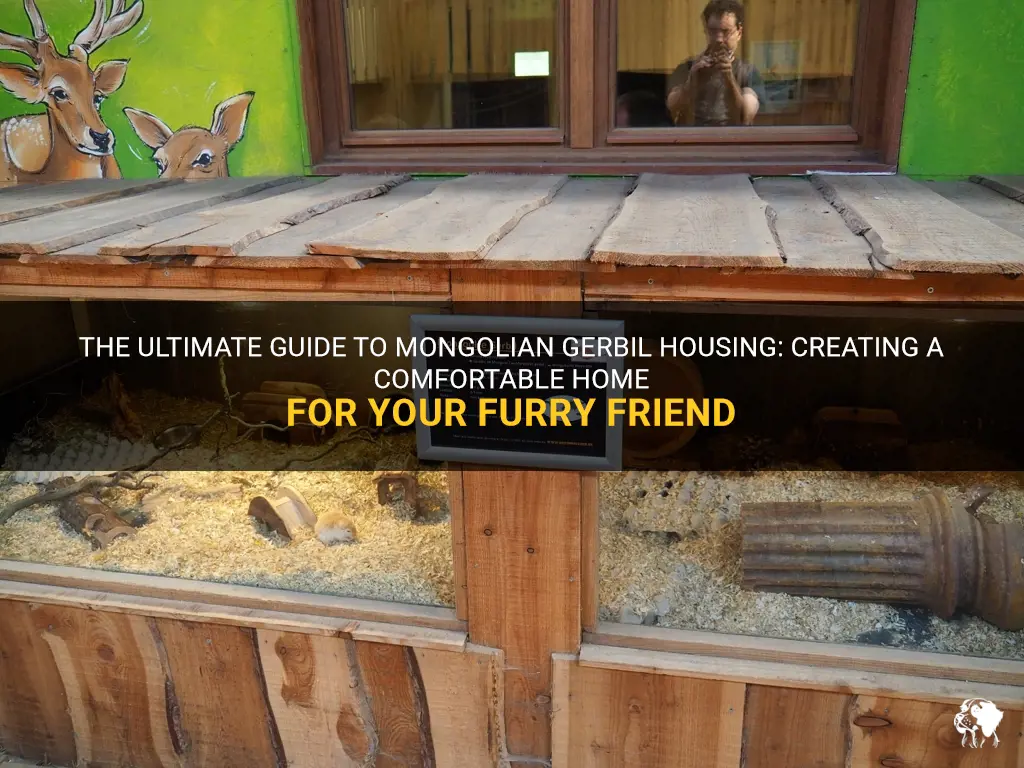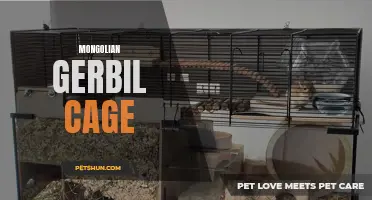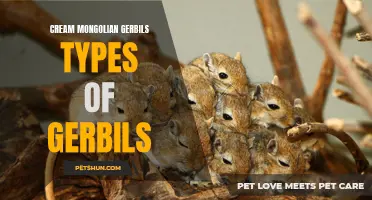
Mongolian gerbils, also known as Mongolian jirds or gerbils, are small rodents that are native to the semi-desert and grassland regions of Mongolia and northern China. These adorable furry creatures make great pets due to their playful and curious nature. However, it is essential to provide them with proper housing to ensure their comfort and well-being. In this article, we will explore the various options for Mongolian gerbil housing, including cages, tanks, and even DIY setups, to help you create the perfect home for your furry friend.
| Characteristics | Values |
|---|---|
| Size of cage | Large |
| Type of bedding | Absorbent |
| Number of levels | Multiple |
| Type of wheel | Silent |
| Retreat or hideout | Yes |
| Chew-resistant materials | Yes |
| Proper ventilation | Yes |
| Easy to clean | Yes |
What You'll Learn
- What are the key factors to consider when choosing housing for a Mongolian gerbil?
- What are the pros and cons of using a cage versus a tank for housing a Mongolian gerbil?
- How much space do Mongolian gerbils need in their housing?
- What types of bedding and substrate are suitable for a Mongolian gerbil's housing?
- Are there any specific features or accessories that are recommended for a Mongolian gerbil's housing, such as tunnels or exercise wheels?

What are the key factors to consider when choosing housing for a Mongolian gerbil?
Mongolian gerbils, also known as desert rats or jirds, are adorable and sociable pets that can bring joy to any household. When choosing housing for these small creatures, there are several key factors to consider to ensure their comfort and well-being.
- Size of the Cage: Mongolian gerbils are active and love to explore, so it's important to provide them with a spacious cage. The minimum recommended size for a pair of gerbils is at least 10 gallons, but larger is always better. A two-level cage or a tank with a secure lid is ideal, as it provides ample space for your gerbils to run, climb, and play.
- Ventilation: Gerbils are sensitive to temperature changes and require good airflow to prevent them from overheating. Ensure that the cage has proper ventilation to allow fresh air to circulate. Avoid placing the cage in direct sunlight or near radiators or other heat sources that could cause the temperature inside the cage to rise.
- Substrate: Gerbils love to dig and burrow, so a suitable substrate is essential. Avoid using pine or cedar shavings, as the aromatic oils can be toxic to gerbils. Opt for a dust-free bedding that is safe for them, such as aspen shavings or paper-based bedding. Providing nesting material like shredded paper or hay will allow the gerbils to create cozy nests.
- Enrichment: Gerbils are highly active animals that require mental stimulation and physical exercise. Provide them with plenty of toys and items to explore, such as tunnels, climbing structures, and chew toys. Gerbils also enjoy having a running wheel, which helps them burn off energy. Make sure the toys and accessories are safe and non-toxic for the gerbils to avoid any potential health issues.
- Easy Cleaning: Regular cleaning is important to maintain a hygienic environment for your gerbils. Look for a cage that has a removable tray or a cage with easy access to facilitate cleaning. It's recommended to clean the cage and change the bedding at least once a week to keep odors and bacteria under control.
- Socialization: Mongolian gerbils are naturally sociable creatures and thrive in pairs or small groups. If you plan to keep multiple gerbils together, ensure that the housing is large enough to accommodate their needs. Avoid housing gerbils from different litters or introducing new gerbils without proper introductions, as this can lead to territorial conflicts.
- Safety: Gerbils are known for their gnawing behavior, which helps keep their teeth healthy but can also pose a risk if they have access to toxic materials or escape-prone enclosures. Check the cage regularly for any sharp edges or loose parts that could cause injury. Keep the cage away from any potential hazards like toxic plants, electrical cords, or other pets that may harm the gerbils.
In conclusion, choosing suitable housing for Mongolian gerbils is crucial for their well-being. Consider the size of the cage, ventilation, substrate, enrichment, ease of cleaning, socialization, and safety when making your choice. By providing the right living environment, you can ensure that your gerbils are happy, healthy, and flourishing companions.
The Importance of Gerbil Animal Shelters in Providing a Safe Haven for Small Rodents
You may want to see also

What are the pros and cons of using a cage versus a tank for housing a Mongolian gerbil?
When it comes to housing a Mongolian gerbil, there are two main options to consider: using a cage or a tank. Both have their own advantages and disadvantages, so it's crucial to weigh them carefully before making a decision.
One of the main advantages of using a cage for housing a Mongolian gerbil is the ventilation it provides. Cages are typically made of wire mesh or bars, allowing for proper airflow and preventing the buildup of odors. This is particularly important for gerbils because they are susceptible to respiratory issues. In addition, cages provide a clear view of your pet, making it easier to monitor their behavior and overall health.
On the other hand, one of the downsides of using a cage is that it can be challenging to find a suitable size. Gerbils are active creatures that require ample space to explore, exercise, and burrow. It's essential to choose a cage that is large enough to accommodate their natural behaviors. Additionally, cages with wide-bar spacing may pose a risk for small gerbils who could potentially squeeze through and escape. So, careful consideration should be given to the size and structure of the cage.
Alternatively, using a tank or aquarium as a housing option for a Mongolian gerbil has its own set of advantages and disadvantages. One significant advantage is the ability to provide a deep bedding substrate, which allows gerbils to burrow and create tunnels. This is vital for their mental and physical wellbeing, as burrowing is a natural behavior for them. Additionally, tanks are escape-proof, ensuring that your gerbil remains safe and secure.
However, one of the drawbacks of using a tank is the potential for poor ventilation. A tank with a solid or partially solid lid may restrict airflow, leading to increased humidity and the accumulation of odors. This can be detrimental to your gerbil's respiratory health. It's important to ensure proper ventilation by using a mesh lid or regular cleaning to maintain a healthy environment for your pet.
In conclusion, both cages and tanks have their own set of pros and cons when it comes to housing a Mongolian gerbil. When choosing between the two options, it's crucial to consider factors such as ventilation, size, and escape-proofing. Ultimately, selecting the right housing option depends on your gerbil's specific needs and your preferences as a pet owner.
What You Need to Consider When Deciding How Many Gerbils to Get
You may want to see also

How much space do Mongolian gerbils need in their housing?
Mongolian gerbils, also known as jirds or desert gerbils, are small rodents that originate from the semi-arid regions of Mongolia and Northern China. These curious and active creatures make great pets and require proper housing to thrive.
When it comes to the space requirements for Mongolian gerbils, it is essential to provide them with a decent-sized cage or tank that allows for exploration and exercise. A good guideline is to provide at least 10 gallons of space per gerbil, but more is always better.
There are several factors to consider when determining the appropriate size of a gerbil's housing. Firstly, gerbils are highly active animals and require ample space to run, dig, climb, and play. Providing a spacious environment allows them to engage in natural behaviors and prevents boredom and lethargy.
Additionally, gerbils are social animals that thrive in pairs or small colonies. Therefore, it is crucial to provide enough space for multiple gerbils to coexist harmoniously. A larger habitat ensures that each gerbil has enough personal space and reduces the likelihood of territorial conflicts.
To maximize the usable space within the gerbil's enclosure, it is advisable to choose a habitat with multiple levels or platforms. This allows gerbils to utilize both vertical and horizontal spaces and provides additional opportunities for exercise and mental stimulation. Some suitable options include cages with multiple levels, glass tanks with ramps and shelves, or DIY setups with interconnected tubes and tunnels.
In addition to providing ample space, the gerbil's housing should also include appropriate bedding and enrichment materials. Gerbils love to dig and burrow, so a deep layer of substrate, such as aspen shavings or paper-based bedding, is essential. This allows them to create tunnels and nests, mimicking their natural habitat.
To further enhance their environment, adding various toys, tunnels, and chew items is recommended. These items provide mental stimulation and help prevent boredom, which can lead to destructive behaviors. Examples of suitable gerbil toys include exercise wheels, tunnels, wooden chews, and even empty toilet paper rolls filled with hay or treats.
Furthermore, proper ventilation and temperature control are crucial to the health and well-being of Mongolian gerbils. The enclosure should have adequate air circulation to prevent the buildup of ammonia and other harmful gases. It is also important to keep the gerbil's habitat away from direct sunlight, drafts, and extreme temperatures, as they are sensitive to temperature fluctuations.
In conclusion, Mongolian gerbils require a spacious and enriching housing environment to thrive. Providing at least 10 gallons of space per gerbil is a good starting point, but more space is always better. The housing should include multiple levels, suitable bedding, and plenty of toys and enrichment items. By creating a comfortable and stimulating habitat, you can ensure that your gerbils lead healthy and happy lives.
The Fascinating Story Behind the Origin of Gerbils
You may want to see also

What types of bedding and substrate are suitable for a Mongolian gerbil's housing?
Mongolian gerbils, also known as Mongolian jirds or Mongolian desert gerbils, are small mammals that make popular pets. When setting up a habitat for these curious and active creatures, it is important to provide suitable bedding and substrate. The right choice of materials can contribute to their overall well-being and comfort.
One of the most popular and widely used bedding options for Mongolian gerbils is aspen shavings. Aspen shavings are safe and non-toxic, making them an ideal choice for small animals. They provide a soft and comfortable surface for gerbils to burrow and dig in, which is a natural behavior for them. Additionally, aspen shavings are relatively dust-free, making them a good option for gerbils with respiratory sensitivities.
Another excellent bedding option for Mongolian gerbils is paper-based bedding. These types of bedding are made from shredded or recycled paper, and they offer a comfortable and absorbent surface for gerbils. Paper-based bedding is also highly absorbent, which helps to control odor and keep the habitat clean. However, it is essential to ensure that the paper-based bedding is free from inks, dyes, or additives that could be harmful to gerbils.
In addition to bedding, a suitable substrate is also necessary for a gerbil's habitat. A substrate refers to the material placed on the bottom of the enclosure, providing a base for the bedding and allowing for natural behaviors such as digging and burrowing.
One common and suitable choice for substrate is a mixture of soil and sand. This simulates the natural environment of gerbils and allows them to exhibit their instinctive behaviors. The soil and sand mixture should be free from pesticides, fertilizers, or any harmful substances that could be toxic to gerbils. It is important to ensure that the substrate is damp but not overly wet to prevent any fungal or bacterial growth.
When selecting bedding and substrate for Mongolian gerbils, it is crucial to consider their natural habitat and preferences. Mongolian gerbils inhabit dry desert regions, so materials that mimic this environment will provide a more enriched and natural habitat for them. Providing appropriate bedding and substrate will not only contribute to their physical comfort but also to their mental stimulation and overall well-being.
In conclusion, suitable bedding and substrate for Mongolian gerbils should provide a soft and comfortable surface for burrowing and digging behaviors. Aspen shavings and paper-based bedding are popular choices, while a mixture of soil and sand can serve as suitable substrate. It is important to ensure the materials are safe, non-toxic, and free from any harmful additives. By considering the natural habitat and preferences of Mongolian gerbils, their housing can be set up to provide them with a comfortable and enriching environment.
The Existence of Wild Gerbils: Unraveling the Mystery
You may want to see also

Are there any specific features or accessories that are recommended for a Mongolian gerbil's housing, such as tunnels or exercise wheels?
Mongolian gerbils, also known as Mongolian jirds or Meriones unguiculatus, are popular small pets due to their friendly and social nature. In order to properly care for these rodents, it is important to provide them with a suitable living environment that mimics their natural habitat.
One of the key features that should be included in a Mongolian gerbil's housing is tunnels. These small rodents are burrowing animals by nature, so providing them with tunnels will allow them to engage in their natural behaviors. Tunnels can be made from a variety of materials such as PVC pipes, cardboard tubes, or even empty toilet paper rolls. It is important to ensure that the tunnels are wide enough for the gerbil to comfortably pass through and that they are securely attached to the cage to prevent any accidents.
Exercise wheels are another important accessory for a Mongolian gerbil's housing. These rodents love to run and play, and an exercise wheel provides them with the opportunity to get the exercise they need. It is important to choose a wheel that is appropriately sized for the gerbil, as one that is too small can cause injury. Ideally, the wheel should have a solid running surface rather than wire spokes, as this can cause harm to the gerbil's delicate feet.
In addition to tunnels and exercise wheels, there are other accessories that can enhance a Mongolian gerbil's living space. One such accessory is a sand bath. Mongolian gerbils have special oil glands on their bellies, and rolling in sand helps to keep their fur clean and healthy. A shallow dish filled with chinchilla sand can be provided for the gerbil to roll around in.
Another accessory that can be beneficial for a Mongolian gerbil is a nesting box. These rodents enjoy having a cozy, private space where they can rest and sleep. A nesting box can be made from a small cardboard box or a wooden hideout, filled with shredded paper or soft bedding material.
It is important to ensure that the gerbil's housing is kept clean and hygienic. Regular spot cleaning should be done to remove any soiled bedding or droppings. The gerbil's cage should also be thoroughly cleaned and disinfected on a regular basis to prevent the buildup of bacteria and odors.
When choosing accessories for a Mongolian gerbil's housing, it is important to consider the safety of the gerbil. Avoid any accessories that have small parts that the gerbil could chew on or swallow, as this can be harmful to their health. It is also a good idea to monitor the gerbil while it is using any new accessories, to ensure that there are no signs of injury or distress.
In conclusion, there are several features and accessories that are recommended for a Mongolian gerbil's housing. Tunnels, exercise wheels, sand baths, and nesting boxes can all enhance the gerbil's living space and provide them with opportunities for mental and physical stimulation. By providing a suitable living environment, gerbil owners can ensure that their pets are happy and healthy.
Why Do Gerbils Shed Their Tails? Understanding the Phenomenon
You may want to see also
Frequently asked questions
The best type of housing for a mongolian gerbil is a wire cage with a solid metal base. This type of cage provides good ventilation for the gerbil and allows for easy cleaning. It also prevents the gerbil from chewing through the sides of the cage, as they are known to be escape artists.
The cage for a mongolian gerbil should be at least 10 gallons in size. It is important to provide enough space for the gerbil to move around and exercise. A larger cage is always better, as it allows for more enrichment and gives the gerbil more room to explore.
While a glass tank can be used as housing for a mongolian gerbil, it is not recommended. Glass tanks do not provide adequate ventilation, which can lead to poor air quality and respiratory issues for the gerbil. They also do not allow for proper climbing and can cause condensation to build up, creating a damp and unhealthy environment. It is best to use a wire cage with a solid metal base for optimal gerbil housing.







